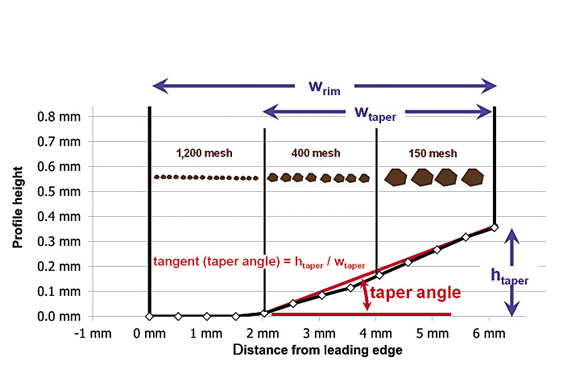Dear Doc: I grind tungsten carbide-tipped saw blades and the sales guy is pushing tri-grit wheels. What’s your take on these?
The Doc Replies: They’re great, and here’s why. Tri-grit wheels have three different grit sizes. The biggest grits on the outer edge of the cup wheel and the medium-sized grits in the middle do all the hard work. The finest grits on the inside impart a fine surface finish—but that’s not the real benefit. Rather, it’s how they easily wear. This produces a flat on the trailing edge of the cup wheel.
Figure 1 shows a measured profile of a worn cup wheel at a company I visited that grinds carbide-tipped endmills. You can see that the fine, 1,200-mesh grits wore away and created a flat. That flat, along with the grit size, will impart a fine surface finish. The larger 150-mesh and 400-mesh grits remove most of the material.
In contrast, with only a single grit size, the taper wears more evenly and eventually you are grinding with a point at the inner rim of the wheel—i.e., without a flat—and this produces a poor surface finish. That’s why a tri-grit wheel can work so well.
Dear Doc: I grind cermet-tipped saw blades with cup wheels and notice that the surface finish eventually deteriorates after truing. Somebody mentioned dressing a taper. How does this work?
The Doc Replies: Cup wheels are horrifically maddening. After truing a cup wheel flat, all the grinding occurs at the leading edge. A taper slowly develops and the grinding shifts from the front of the wheel to the bottom. That’s fine, but eventually this taper nearly turns into a point and surface finish deteriorates while grinding temperatures rise.
Some companies true a taper into the wheel, but that’s not ideal either. The best situation is to true a taper and a flat (Figure 1). The taper does the work while the flat imparts a good surface finish.

Figure 1. The measured profile of a worn cup wheel. Image courtesy J. Badger.
What taper angle should you true? For a 5mm-wide rim, use 1.5mm for the flat width (wflat). This leaves 3.5mm for the taper width (wtaper). The taper height (htaper) is the DOC. Therefore, the equation for the taper angle is tangent (taper angle) = htaper ÷ wtaper. Let’s say you’re taking a 0.5mm DOC; then the tangent (taper angle) is 0.5 ÷ 3.5 and the taper angle is 8.1°.
Keep in mind, this is for single-direction grinding. For two-direction grinding, you’ll have two tapers and a flat in the middle. CTE
About the author: Dr. Jeffrey Badger is an independent grinding expert. The Doc will be giving his 3-day Carbide Master Grinder Clinic in Biberach, Germany, this fall. www.TheGrindingDoc.com
Related Glossary Terms
- dressing
dressing
Removal of undesirable materials from “loaded” grinding wheels using a single- or multi-point diamond or other tool. The process also exposes unused, sharp abrasive points. See loading; truing.
- flat ( screw flat)
flat ( screw flat)
Flat surface machined into the shank of a cutting tool for enhanced holding of the tool.
- grinding
grinding
Machining operation in which material is removed from the workpiece by a powered abrasive wheel, stone, belt, paste, sheet, compound, slurry, etc. Takes various forms: surface grinding (creates flat and/or squared surfaces); cylindrical grinding (for external cylindrical and tapered shapes, fillets, undercuts, etc.); centerless grinding; chamfering; thread and form grinding; tool and cutter grinding; offhand grinding; lapping and polishing (grinding with extremely fine grits to create ultrasmooth surfaces); honing; and disc grinding.
- grit size
grit size
Specified size of the abrasive particles in grinding wheels and other abrasive tools. Determines metal-removal capability and quality of finish.
- reaction injection molding ( RIM)
reaction injection molding ( RIM)
Molding process that allows the rapid molding of liquid materials. The injection-molding process consists of heating and homogenizing plastic granules in a cylinder until they are sufficiently fluid to allow for pressure injection into a relatively cold mold, where they solidify and take the shape of the mold cavity. For thermoplastics, no chemical changes occur within the plastic, and, consequently, the process is repeatable. The major advantages of the injection-molding process are the speed of production; minimal requirements for postmolding operations; and simultaneous, multipart molding.
- sawing machine ( saw)
sawing machine ( saw)
Machine designed to use a serrated-tooth blade to cut metal or other material. Comes in a wide variety of styles but takes one of four basic forms: hacksaw (a simple, rugged machine that uses a reciprocating motion to part metal or other material); cold or circular saw (powers a circular blade that cuts structural materials); bandsaw (runs an endless band; the two basic types are cutoff and contour band machines, which cut intricate contours and shapes); and abrasive cutoff saw (similar in appearance to the cold saw, but uses an abrasive disc that rotates at high speeds rather than a blade with serrated teeth).
- truing
truing
Using a diamond or other dressing tool to ensure that a grinding wheel is round and concentric and will not vibrate at required speeds. Weights also are used to balance the wheel. Also performed to impart a contour to the wheel’s face. See dressing.








